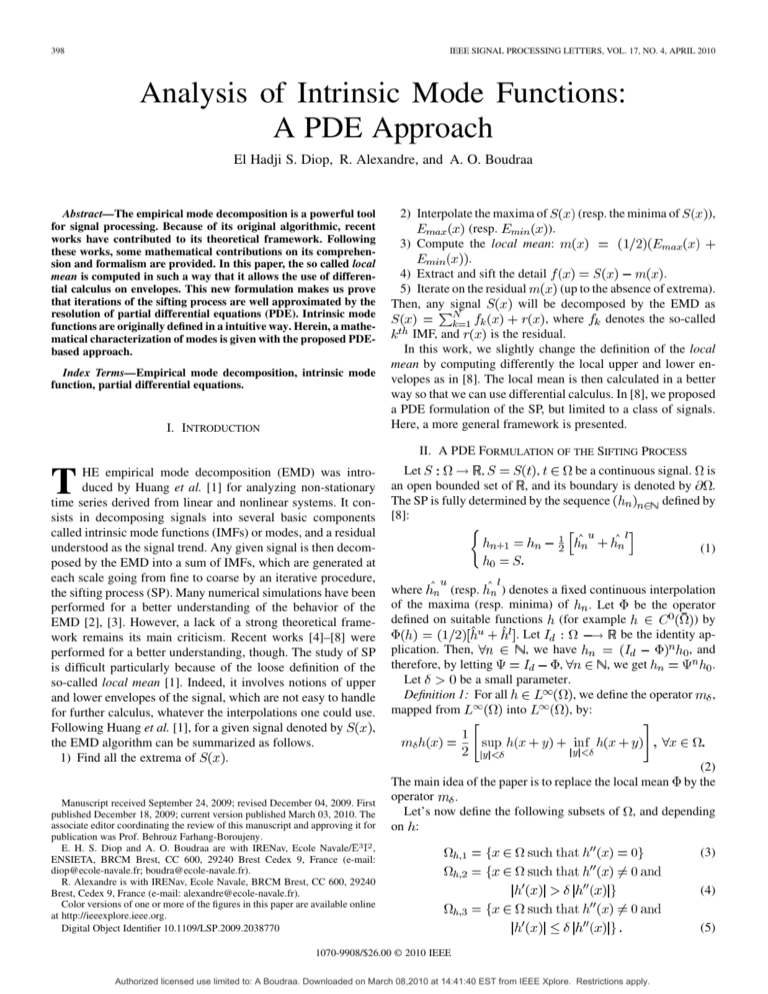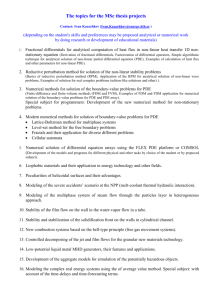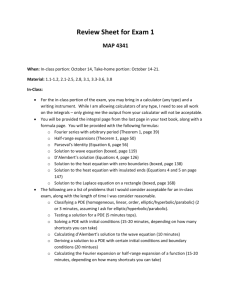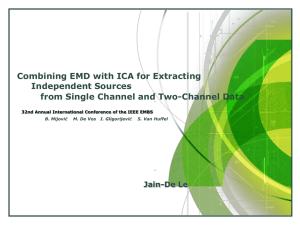Analysis of Intrinsic Mode Functions: A PDE Approach
advertisement

398 IEEE SIGNAL PROCESSING LETTERS, VOL. 17, NO. 4, APRIL 2010 Analysis of Intrinsic Mode Functions: A PDE Approach El Hadji S. Diop, R. Alexandre, and A. O. Boudraa Abstract—The empirical mode decomposition is a powerful tool for signal processing. Because of its original algorithmic, recent works have contributed to its theoretical framework. Following these works, some mathematical contributions on its comprehension and formalism are provided. In this paper, the so called local mean is computed in such a way that it allows the use of differential calculus on envelopes. This new formulation makes us prove that iterations of the sifting process are well approximated by the resolution of partial differential equations (PDE). Intrinsic mode functions are originally defined in a intuitive way. Herein, a mathematical characterization of modes is given with the proposed PDEbased approach. Index Terms—Empirical mode decomposition, intrinsic mode function, partial differential equations. I. INTRODUCTION (resp. the minima of ), 2) Interpolate the maxima of (resp. ). 3) Compute the local mean: . . 4) Extract and sift the detail 5) Iterate on the residual (up to the absence of extrema). will be decomposed by the EMD as Then, any signal , where denotes the so-called IMF, and is the residual. In this work, we slightly change the definition of the local mean by computing differently the local upper and lower envelopes as in [8]. The local mean is then calculated in a better way so that we can use differential calculus. In [8], we proposed a PDE formulation of the SP, but limited to a class of signals. Here, a more general framework is presented. II. A PDE FORMULATION OF THE SIFTING PROCESS T HE empirical mode decomposition (EMD) was introduced by Huang et al. [1] for analyzing non-stationary time series derived from linear and nonlinear systems. It consists in decomposing signals into several basic components called intrinsic mode functions (IMFs) or modes, and a residual understood as the signal trend. Any given signal is then decomposed by the EMD into a sum of IMFs, which are generated at each scale going from fine to coarse by an iterative procedure, the sifting process (SP). Many numerical simulations have been performed for a better understanding of the behavior of the EMD [2], [3]. However, a lack of a strong theoretical framework remains its main criticism. Recent works [4]–[8] were performed for a better understanding, though. The study of SP is difficult particularly because of the loose definition of the so-called local mean [1]. Indeed, it involves notions of upper and lower envelopes of the signal, which are not easy to handle for further calculus, whatever the interpolations one could use. , Following Huang et al. [1], for a given signal denoted by the EMD algorithm can be summarized as follows. . 1) Find all the extrema of Manuscript received September 24, 2009; revised December 04, 2009. First published December 18, 2009; current version published March 03, 2010. The associate editor coordinating the review of this manuscript and approving it for publication was Prof. Behrouz Farhang-Boroujeny. E. H. S. Diop and A. O. Boudraa are with IRENav, Ecole Navale/E I , ENSIETA, BRCM Brest, CC 600, 29240 Brest Cedex 9, France (e-mail: diop@ecole-navale.fr; boudra@ecole-navale.fr). R. Alexandre is with IRENav, Ecole Navale, BRCM Brest, CC 600, 29240 Brest, Cedex 9, France (e-mail: alexandre@ecole-navale.fr). Color versions of one or more of the figures in this paper are available online at http://ieeexplore.ieee.org. Digital Object Identifier 10.1109/LSP.2009.2038770 , , be a continuous signal. is Let . an open bounded set of , and its boundary is denoted by defined by The SP is fully determined by the sequence [8]: (1) (resp. ) denotes a fixed continuous interpolation where of the maxima (resp. minima) of . Let be the operator ) by defined on suitable functions (for example . Let be the identity application. Then, , we have , and , , we get . therefore, by letting be a small parameter. Let , we define the operator , Definition 1: For all mapped from into , by: (2) The main idea of the paper is to replace the local mean by the operator . Let’s now define the following subsets of , and depending on : 1070-9908/$26.00 © 2010 IEEE Authorized licensed use limited to: A Boudraa. Downloaded on March 08,2010 at 14:41:40 EST from IEEE Xplore. Restrictions apply. (3) (4) (5) DIOP et al.: ANALYSIS OF INTRINSIC MODE FUNCTIONS: A PDE APPROACH As usual, we shall use the norm . such that Theorem 1: Let For small, one has 399 for any is bounded on . (11) (6) (12) (7) (13) (8) Definition 2: A Proof: See the Appendix. We recall the sequence and virtual IMFs as: quence which holds for approximate . Then, we define the se, where (9) and , , then: is chosen small enough. Let given by (10) Let’s consider a smoothed enough interpolation of also denoted, with some notation abuse, by . Using Taylor expansion, one has . Thus, choosing yields the following. , then: • If . and • If then . and • If then: and on on , which Certainly, we need to add a boundary condition on on will depend on the input signal . For instance, if , we shall take a Dirichlet boundary condition. On the other hand, if on , a Neumann boundary condition or more generally, a mixed Robbin type boundary condition is considered. Next, we derive from the PDE (15), a particular model by only considering the second equation assumed to be well posed everywhere. is a Definition 3: A function defined as , a , (16) for some , where is solution of the PDE: (17) , , . • If then is solution of the free-boundary PDE: on . Let us next fix (14) (15) . • If defined as: , for some Thanks to Theorem 1, (9) is developed as follows. • If , then: . and , then • If . and , then • If is a function , . In view of the above computations, it is therefore natural to in, troduce for any smooth and fixed function , the following subsets: We need of course to specify boundary conditions: we shall consider mainly Dirichlet or Neumann type conditions. The PDE (17) could be rewritten as a backward Heat equation, and is shown to be well posed in [8]. Concepts of -IMF are introduced as follows. Definition 4: We say that a function is a -IMF if and only if 1) is a solution of the PDE (17); is a null mean function for some . 2) In practice, a -IMF is extracted when its mean is almost zero. , is extracted by resolving (17), Once the first -IMF, we resolve again (17) to get , but the initial condition ; is now equal to the residual between the signal and and so on for other -IMFs. Authorized licensed use limited to: A Boudraa. Downloaded on March 08,2010 at 14:41:40 EST from IEEE Xplore. Restrictions apply. 400 IEEE SIGNAL PROCESSING LETTERS, VOL. 17, NO. 4, APRIL 2010 Definition 6: -EMD is the decomposition for which -IMFs are extracted with (17). III. NUMERICAL RESULTS PDEs are implemented with an explicit scheme. We first consider the following signal: (18) Fig. 1. Comparisons between classical IMFs and -IMFs for the first signal given by (18). The two first modes are displayed in Figs. 1(a) and (b), respectively. A first remark is that the -EMD behaves like the classical EMD, in the sense that it separates the signal’s components from the highest frequency to the lowest one. One could notice the small attenuation of the -IMFs as regards to the exact values of the signal and the IMFs. -IMFs are obtained with Neumann and . The second boundary conditions, simulated signal is given by (19) Figs. 2(a) and (b) show the first two modes, which should normally equal to and respectively. The signal’s components and are very well separated by our approach. fit exactly and respectively. On the other hand, is almost the same as , except at boundaries where we notice totally some little differences (Fig. 2(a)). On the contrary, differs from (Fig. 2(b)). Probable reasons for that are the well known boundary problems that occur during the SP, and are obviously due to the mean envelopes computed by interpolations (splines for examples). The last signal is (20) (Fig. Despite a little attenuation of the amplitude of 3(b)), this example clearly illustrates again the relevance and efficiency of the proposed -EMD. For the last two examples, -IMFs are obtained with Dirichlet boundary conditions, and , and and , respectively. Fig. 4 shows comparisons between -IMFs and modes obtained by implementing (15), for the first (cf. (20)) and third signal [cf. (20)] considered before [Figs. 4(a)–(d)]. We assume is a null mean function for some , with as soluthat tion of (15). There is no attenuation and modes fit exactely the first signal’s components [Fig. 1(a)–(b) versus Fig. 4(a)–(b)]. In fact, PDE (15) takes into account critical points of the signal and points that have a null second derivative. Also, it accounts the concavity and the convexity of the signal, and handles points for which the signal’s first derivative is above or beneath the second derivative. Fig. 2. Comparisons between classical IMFs and -IMFs for the second signal given by (19). Fig. 3. Comparisons between classical IMFs and -IMFs for the last signal given by (20). IV. CONCLUSION Some theoretical contributions on the comprehension and the formalism of the EMD are provided here. In fact, we propose to perform the SP by the resolution of PDEs, and analytical characterizations of modes are then proposed. Moreover, a suitable way for getting rid of interpolation’s issues is also provided. Further investigations of the PDE based approach should be done. Indeed, the parameter is actually chosen empirically, and . The stopping we make the assumption that criterion needs also some refinements, because if the signal has a null mean, then the algorithm stops at the first iteration, which means that any function that has a null mean is then a -IMF. An alternative to that is to consider the free-boundary PDE (15). APPENDIX Before giving the proof of Theorem 1, we first introduce opand , respectively defined for all by erators and , Authorized licensed use limited to: A Boudraa. Downloaded on March 08,2010 at 14:41:40 EST from IEEE Xplore. Restrictions apply. DIOP et al.: ANALYSIS OF INTRINSIC MODE FUNCTIONS: A PDE APPROACH 401 , and then . — If , that is , then: , that is — If . This implies that • If thus again (24) , then is convex; and (25) • If , is then concave. Thus (26) Fig. 4. Comparisons between -IMFs and obtained modes with (15). (a), (b): first signal (cf. (19)). (c), (d): third signal (cf. (19)). In green: signal’s components, in blue: IM F s and in red: modes obtained with (15). 0 A similar result for is of course true. so that is bounded on . For Theorem 3: Let small, one has (27) [8]. Then, (cf. Definition 2) is simply written as . so that is bounded on . Theorem 2: Let small, one has Then for . Furthermore where again (21) if and otherwise. . Furthermore where (28) if and otherwise. , for any Proof: For any and , since that we can write, using Taylor’s formula: and (22) such , . By taking the supremum in , in view of the Definition of , one gets . In order to prove the the result, with the definition of for any fixed , explicit formula for we first note that: and . • case 1: If . Then and thus (23) • case 2: If . denotes the derivative of w.r.t and so on, If then: , . is either convex Note that in particular of course or concave w.r.t. . Therefore Proof of Theorem 1: Just consider results obtained for in Theorems 2 and 3, respectively. REFERENCES [1] N. Huang, Z. Shen, S. Long, M. Wu, H. Shih, Q. Zheng, N.-C. Yen, C. C. Tung, and H. H. Liu, “The empirical mode decomposition and the hilbert spectrum for nonlinear and non-stationary time series analysis,” Roy. Soc., vol. 454, pp. 903–995, 1998. [2] P. Flandrin and G. Rilling, “Empirical mode decomposition as a filter bank,” IEEE Signal Process Lett., vol. 11, no. 2, pp. 112–114, Feb. 2004. [3] P. Flandrin and P. Goncalves, “Empirical mode decompositions as data-driven wavelet-like expansions,” IJWMIP, vol. 2, no. 4, pp. 1–20, Aug. 2004. [4] E. Delechelle, J. Lemoine, and O. Niang, “Empirical mode decomposition: An analytical approach for sifting process,” IEEE Signal Process. Lett., vol. 12, no. 11, pp. 764–767, Nov. 2005. [5] R. C. Sharpley and V. Vatchev, “Analysis of the intrinsic mode functions,” Construct. Approx., vol. 24, pp. 17–47, 2006. [6] S. Meigen and V. Perrier, “A new formulation for empirical mode decomposition based on constrained optimization,” IEEE Signal Process. Lett., vol. 14, no. 12, pp. 932–935, Dec. 2007. [7] V. Vatchev and R. Sharpley, “Decomposition of functions into pairs of intrinsic mode functions,” Roy. Soc. London A, vol. 464, pp. 2265–2280, 2008. [8] E. H. S. Diop, R. Alexandre, and A. O. Boudraa, “A pde characterization of the intrinsic mode functions,” in IEEE ICASSP, Taipei, Taiwan, 2009, pp. 3429–3432. Authorized licensed use limited to: A Boudraa. Downloaded on March 08,2010 at 14:41:40 EST from IEEE Xplore. Restrictions apply.








